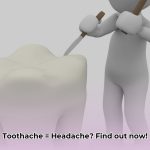“`markdown
Extract Infected Tooth: Your Complete Guide to Pain Relief and Recovery
Is a throbbing toothache disrupting your life? Concerned about an infection? You’re not alone. This comprehensive guide provides everything you need to know about dealing with an infected tooth, from recognizing the danger signs to understanding extraction procedures and ensuring a smooth recovery. We’ll break down the process in simple terms, address your questions, and equip you with practical tips for a pain-free smile and lasting oral health. For information on toothaches and headaches, see this helpful article: Toothache Headaches.
Understanding Infected Teeth and the Need for Extraction
A painful, infected tooth can significantly impact your daily life, making eating, sleeping, and even talking a challenge. Knowing your treatment options and what to expect can alleviate anxiety and empower you to make informed decisions. This guide explores the complexities of infected teeth, outlines when extraction becomes necessary, describes the extraction procedure, and provides essential aftercare tips for a swift recovery. Let’s dive into immediate pain relief strategies and explore tooth extraction as a viable solution.
Why Removing an Infected Tooth is Crucial
Picture your mouth as a battleground. An infected tooth becomes a stronghold for harmful bacteria, leading to intense pain, swelling, and potentially even fever. While dentists prioritize saving natural teeth whenever possible, extraction becomes necessary when antibiotics and root canal treatments fail to eliminate the infection. Removing the infected tooth prevents the spread of bacteria to other parts of your body, safeguarding your overall health. It’s often a last resort, but a critical step in regaining your well-being. Why is prompt removal of an infected tooth so important for your overall health?
Determining When Extraction is the Only Option
Your dentist plays a crucial role in determining the appropriate course of treatment. During a comprehensive examination, they’ll assess the severity of the infection, location of the affected tooth (wisdom teeth can present unique challenges), and your overall health. Less complicated cases may be resolved with a simple extraction. However, deeply infected or impacted teeth often require a surgical extraction, which involves a more complex procedure, potentially including incisions in the gum and bone. What are the key factors that differentiate between simple and surgical tooth extractions?
What to Expect During the Extraction Procedure
The tooth extraction procedure typically involves numbing the area with local anesthesia to minimize discomfort. For simple extractions, the dentist uses forceps to gently loosen and remove the tooth. More complex surgical extractions involve making a small incision in the gum to gain access to the tooth. The dentist may also need to remove some bone tissue to facilitate extraction. After the tooth is removed, the dentist will clean the extraction site and may place stitches to promote healing. What type of anesthesia is typically used during a tooth extraction, and how does it minimize discomfort?
Your Healing Journey: Recovering After Tooth Extraction
Treat the extraction site like a small wound that requires careful attention and time to heal. Following your dentist’s instructions diligently is essential for a smooth and uneventful recovery. Here are some key steps to take:
- Gentle Oral Hygiene: Brush and floss your teeth gently, carefully avoiding the extraction site for the first few days.
- Soft Food Diet: Stick to a diet of soft foods, such as mashed potatoes, yogurt, and soup, to minimize irritation and allow the area to rest.
- Medication Adherence: Take prescribed pain relievers and antibiotics as directed to manage pain and prevent infection.
- Avoid Smoking: Smoking significantly impairs the healing process, increasing the risk of complications.
- Salt Water Rinses: Gently rinse your mouth with salt water several times a day to keep the extraction site clean.
Preventing Potential Complications
While tooth extractions are generally safe, complications can occur. One potential issue is “dry socket,” a painful condition that arises when the blood clot dislodges prematurely. Following your dentist’s aftercare instructions carefully can significantly reduce the risk of developing dry socket. Other less common complications can include infection or nerve damage. Your dentist is your best resource for addressing any questions or concerns you may have during the recovery period. How can proper aftercare minimize the risk of dry socket and other complications following a tooth extraction?
Choosing the Right Dental Professional
Selecting a dentist with experience in performing tooth extractions is crucial for ensuring a safe and successful procedure. Seek recommendations from friends, family, or online reviews. Choose a dentist with whom you feel comfortable and trust their expertise. Why is it important to find a dentist who is experienced in tooth extractions?
Exploring Alternatives to Tooth Extraction
In some cases, alternative treatments may be available to save an infected tooth. Root canal therapy, for example, involves removing the infected pulp and sealing the tooth to prevent further infection. Antibiotics may also be prescribed to combat the infection. However, if these treatments are unsuccessful, extraction may be the only option to eliminate the infection and prevent further complications. What are the potential benefits and drawbacks of pursuing alternative treatments to tooth extraction?
Understanding the Cost of Tooth Extraction
The cost of a tooth extraction varies depending on several factors, including the complexity of the extraction, the location of the tooth, and your dental insurance coverage. Simple extractions typically cost less than surgical extractions. It’s always a good idea to discuss the estimated cost with your dentist upfront to avoid any surprises. What factors influence the overall cost of a tooth extraction procedure?
Maintaining Long-Term Oral Health to Prevent Future Problems
The best way to address infected teeth is to prevent them from occurring in the first place. Regular dental checkups, consistent brushing and flossing, and a healthy diet are critical for maintaining optimal oral health. Preventive care is less expensive and more comfortable than dealing with a painful infection or the need for extraction. How can a proactive approach to oral hygiene minimize the need for future tooth extractions?
Recognizing When to Seek Immediate Dental Care
If you suspect you have a tooth infection, don’t delay seeking professional dental care. Contact your dentist immediately for an evaluation. Early intervention can significantly improve your chances of a faster recovery and prevent the development of more serious complications. Why is it so important to seek immediate dental care if you suspect a tooth infection?
Root Canal vs. Extraction: Making the Right Choice for Your Infected Tooth
- Preserving your natural tooth through root canal therapy offers long-term benefits for oral health.
- Advanced root canal techniques increase the likelihood of successfully saving your tooth.
- While tooth extraction provides a faster solution, it often necessitates replacement, which can impact long-term costs and comfort.
Evaluating Your Options: Root Canal Therapy vs. Tooth Extraction
Deciding how to treat a severely infected tooth can be stressful. The two primary options are root canal therapy and tooth extraction. Working closely with your dentist is key to determining the best approach for your individual needs. How to choose between root canal and extraction for an infected tooth is best answered after a thorough examination.
Root canal therapy aims to eliminate the infection within the tooth’s root. The procedure involves cleaning and sealing the infected pulp chamber to prevent further decay and preserve the natural tooth. Think of it like a targeted treatment to remove the source of the infection while keeping the tooth intact. Is root canal therapy generally considered the preferred approach for long-term oral health?
Tooth extraction, on the other hand, involves removing the infected tooth entirely. It’s a quicker and often less expensive procedure than a root canal. However, it’s important to remember that extraction creates a gap that will eventually need to be filled by a replacement tooth, such as an implant or bridge. What are the potential benefits and drawbacks of choosing tooth extraction versus root canal therapy?
Key Factors Guiding Your Decision
Several factors will influence the best course of treatment for your specific situation. Your dentist will consider:
- Severity of the Infection: A mild infection may respond well to root canal therapy, while a severely damaged tooth may require extraction.
- Tooth’s Structural Integrity: A cracked or extensively damaged tooth may not be suitable for root canal treatment.
- Your Overall Health: Systemic health conditions, such as diabetes, can affect healing and influence the treatment choice.
- Financial Considerations: Root canals are typically more expensive than extractions, but extraction necessitates subsequent replacement, adding to the overall cost.
- Your Personal Preferences: You and your dentist should collaborate to develop a treatment plan that aligns with your goals and comfort level.
The Benefits of Root Canal Therapy
Root canal therapy offers the potential to save your natural tooth. During the procedure, the infected pulp is removed, the canals are thoroughly cleaned, and the tooth is sealed to prevent future infection. Modern techniques, such as PIPS/SWEEPS laser technology, enhance the effectiveness of root canal treatment. While it’s a more involved procedure, it’s generally considered the best long-term option for preserving your natural tooth. What role do advanced technologies play in improving the success rates of root canal therapy?
The Tooth Extraction Process
Tooth extraction is a straightforward procedure that involves removing the infected tooth. It’s often quicker and less expensive than root canal therapy. However, it’s crucial to remember that you’ll need to replace the missing tooth to maintain proper function and aesthetics. Replacement options include implants, bridges, or dentures, each with its own set of pros and cons. What are the different tooth replacement options available following extraction, and what factors should be considered when making a choice?
Working Together to Make the Right Choice
Ultimately, how to choose between root canal and extraction for an infected tooth is a decision that you and your dentist make together. They’ll carefully evaluate your situation, explain the available options, and help you select the course of treatment that best meets your individual needs and goals.
Preventing Future
- Find Premium Personal Growth Clipart Now: Boost Your Content - October 19, 2025
- Unlock Your Potential: Top Personal Growth Blogs 2024 - October 16, 2025
- Discover Unforgettable Yachting Experiences for Personal Growth: Transform Your Life at Sea - October 14, 2025
















